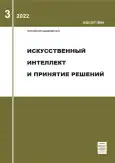编号 3 (2022)
System, Evolutionary, Cognitive Modeling
Data Science: Methodology, Main Directions, Problems and Perspectives
摘要
Data science as a special science has appeared in the early 2000s. It’s appearence was a kind of response of the scientific community to the challenges of big data. It has now reached a level of maturity that makes it a science, playing an important and indispensable role in the cluster of information sciences dealing with the problems of data collection, storage, presentation and use. The paper outlines the boundaries of data science in relation to artificial intelligence. It describes the multiple two-way relationships of data science and other related sciences dealing with data, and in brief introduces to the data science methodology and its main scientific fields. Finally, the paper indicates the main sources of challenges and difficult problems thouse are expected to be solved by the data science.
 3-20
3-20


Information-Logical Model of Scientific and Technological Potential of Preventive and Personalized Medicine
摘要
Personalization of medicine is a modern concept of health care. The paper outlines the goals and objectives of preventive and personalized medicine. A multi-level hierarchical information-logical structure has been formed for system modeling of development trends in preventive and personalized medicine. Methods for multi-aspect evaluation and selection of promising high technologies in preventive and personalized medicine are proposed.
 21-35
21-35


Decision Support Systems
Neuro-Symbolic Artificial Intelligence in Collaborative Decision Support Systems
摘要
The paper discusses the requirements for collaborative human-machine decision support systems and the problems that arise during their creation. The methods of neuro-symbolic artificial intelligence can help to resolve some of these problems. The analysis of modern results in the field of ontology-oriented neuro-symbolic artificial intelligence is carried out, primarily aimed at explaining neural network models using ontologies and using symbolic knowledge to improve the efficiency of neural network models. A conceptual model of a collaborative human-machine decision support system based on ontology-oriented neuro-symbolic intelligence is proposed.
 36-50
36-50


Intelligent Recommender Systems for Medicine: Peculiarities and Limitations
摘要
A particularity of intelligent recommender systems for the medical subject area is the need to take into account numerous diverse signs, and the limitation is due to the need to control recommendations issued by a physician. Direct transmission of recommendations to the user is not possible, since it is necessary to ensure the safety of the patient during their implementation. The absence of deviations in health unknown to the individual at the input of the system can threaten with irreversible consequences. This must be taken into account in the architecture of recommender systems for health protection.
 51-62
51-62


Optimal and Rational Choice
Pareto Set Reduction Based on Information about a Type-2 Fuzzy Preference Relation. Algorithm Description
摘要
A multicriteria choice problem is considered in a case when preferences of a decision maker are expressed with a type-2 fuzzy binary relation. An algorithm for Pareto set reduction based on fuzzy quanta of information about preferences of the decision maker is presented. An example of its application is also discussed.
 63-71
63-71


Application of Pareto Frontier in Searching for Compromise Rules of Lake Baikal's Level Control
摘要
Computer decision support technique for the search for compromise rules of Lake Baikal's level control and of Angara River water resovoir cascade control is described. The proposed technique takes into account presence of contradictory requirements that give rise to the vector of decision criteria. The technique is based on dialogue Pareto frontier visualization. It supports the experts in the process of searching for efficient tradeoff among requirements and helps to justify their choice. By using the technique, a compromise cascade control rule was constructed that corresponds to all principle requirements and is used now as a basis of governmental documents concerning water resources control of the Angara River basin.
 72-87
72-87


Multi-Criteria Assessment of Publication Effectiveness of Organization Scientific Departments
摘要
The article considers a new approach to the multi-criteria assessment of publication effectiveness of organization scientific departments using information resources that include data on employees’ publications, and the method ARAMIS for group verbal decisionanalysis. The information service is designed to generate reports on the results of organization scientific activities.
 88-95
88-95


Analysis of Textual and Graphical Information
Method for Training Decision Trees with Non-Linear Splitters
摘要
Univariate decision trees, used in the processing of sparse large dimentional data, have low computational efficiency. Multivariate decision trees are more expressive when classifying data, but overfit on small datasets. The paper proposes a method for learning trees with multidimensional nonlinear splitters, which improves the accuracy of classification on sets of images and texts. This is achieved by jointly optimizing the distance from the objects of the training dataset to the separating hyperplane and the data impurity criterion when building each node of the tree. Test results confirm the effectiveness of the method.
 96-105
96-105


Methods for Combining Multiple Text Recognition Results
摘要
The task of per-frame combination of text recognition results from multiple images is an important component of video stream document recognition systems. Currently there is no unified approach to solving this problem which would yield a high precision of text recognition. In this paper a comparative study is presented of known approaches to the combination of recognition results for identity document fields. It was demonstrated that different approaches are advantageous on different parts of the data sets, while a sepection of the potential best single result can still significantly outperform all the analyzed methods.
 106-116
106-116











